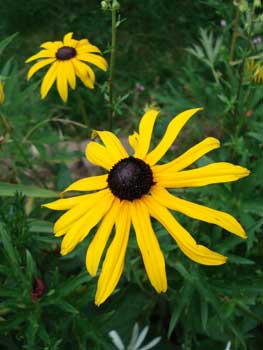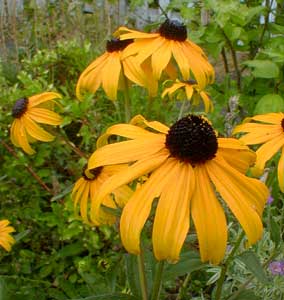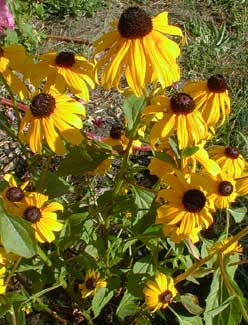
'Goldsturm' Black-eyed Susan; or,
Orange Coneflowers; or,
Sullivant's Rudbeckia
"I bring fresh showers for the thirsting flowers,
From the seas & the streams;
I bear light shade for the leaves when laid
In their noonday dreams."
-"The Cloud"
by Percy Bysshe Shelley
(1792-1822)
by Percy Bysshe Shelley
(1792-1822)
 Growing in our roadside sun-garden, amidst closely related Echinaceas, we have a large clump of 'Goldsturm' Black-Eyed Susan. This cultivar was 1999's Perennial Plant of the Year. But it is by no means as recent a cultivar as that; it's an old garden standard & by far the most popular cultivar of Rudbeckia fulgida.
Growing in our roadside sun-garden, amidst closely related Echinaceas, we have a large clump of 'Goldsturm' Black-Eyed Susan. This cultivar was 1999's Perennial Plant of the Year. But it is by no means as recent a cultivar as that; it's an old garden standard & by far the most popular cultivar of Rudbeckia fulgida.Its popularity has led seed sellers to offer other yellow varieties of Rudbeckia falsely as 'Goldsturm,' though the real thing does not grow true from seeds. You can only be certain of the variety if purchased in full bloom at about gallon-sized, for a maturing plant shows itself to be a foot shorter, more compactly leafed, & with showier flowers than other golden Rudbeckias, not that "lesser" strains are also quite beautiful but bigger, taller, more aggressive, & more apt to flop over.
'Goldsturm' is propagated by division, not with seeds, & its rhizomitous spread can be swift enough to make division sufficiently productive for average gardening purposes. If never divided it will slowly spread into a pleasant tall groundcover.
The variant that became 'Goldsturm' was first noticed by Heinrich Hagemann in 1937 while visiting a Czecklosovakian nursery, where he spotted & purchased an unusually bright specimen of R. fulgida var. sullivantii. Bringing this find to his German employer Karl Foerster, it was propogated as a unique strain, & in 1949 entered the nursery trade under the name 'Goldsturm,' which means "Golden Storm."
 So back to us from Europe came this North American wildflower, as Black-Eyed Susans grow wild throughout the American southeast & Great Lakes region. The variant sullivantii is native from Connecticutt to West Virginia, & inland as far as Michigan & Missouri. There are twenty-five species of Rudbeckia all native to North America, & only R. hirta, an annual, is more widely gardened than R. fulgida.
So back to us from Europe came this North American wildflower, as Black-Eyed Susans grow wild throughout the American southeast & Great Lakes region. The variant sullivantii is native from Connecticutt to West Virginia, & inland as far as Michigan & Missouri. There are twenty-five species of Rudbeckia all native to North America, & only R. hirta, an annual, is more widely gardened than R. fulgida.The genus name was bestowed by the Swedish botanist Carolus Linnaeus (1707-1778) after Olof Rudbeck the Elder (1630-1702) & Olof Rudbeck the Younger (1660-1740), whose first names are sometimes given as Olaf. Both were professors of medicine at Uppsala University; & both held a very great & influential interest in botany, the elder Olof having founded an important botanical garden in Uppsala, which still exists & is today called the Linnaean Garden.
The species name means "Resplendant" because the flowers are that. The variant name refers to botanist William Starling Sullivant (1803- 1873). Sullivant was born in Ohio, & was first to describe many native plants of central Ohio, of the Alleganies from Maryland to Georgia, & of Cuba.
The deepest yellow petals of 'Goldsturm' surround a cone that is deep brown to nearly black. Flowering period is variable, but in our garden it generally starts blooming in mid-July & increasingly flowerful through August. IDeadheading insures rebloom well into October, or even into November if there haven't been many frosty nights. It's just damnably reliable for the length of time the flowers last & for the bold appearance while in bloom.
It belongs on the fringes of a garden where it gets very little shade. Though moderately drought tolerant, it prefers moist well drained soil to produce clouds of golden blossoms. Whether too dry or too moist, it may brown in the lower center, but is easily dressed back to a high standard for its next round of flowers. It can be grow in USDA zones 4 to 9, possibly stretchable for zones 3 through 10; but it is not nearly as longlived at the colder end of its tolerances.
Continue to:
Rudbeckia hirta 'Prairie Sun' Gloriosa Daisy